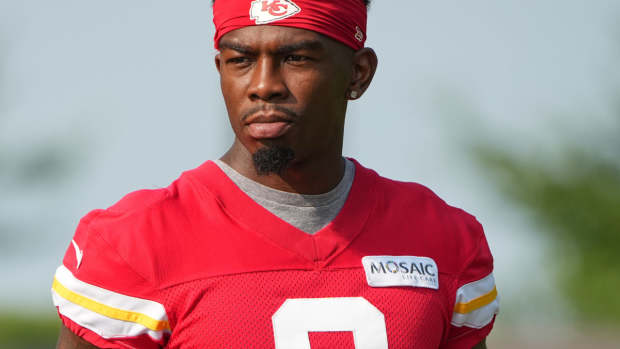Kansas City Chiefs release Super Bowl-winning wide receiver Justyn Ross just days ahead of training camp.
The Kansas City Chiefs have released Super Bowl-winning wide receiver Justyn Ross just days before the start of training camp, a move that lands with a thud in a locker room accustomed to tough roster math but still jarring given the promise, perseverance, and emotional investment that have trailed Ross from his dazzling college breakout through a winding professional journey in Kansas City. For a fan base that cheered every incremental step of his comeback from serious medical setbacks and roster uncertainty, the decision feels less like a routine cut and more like the closing of a chapter that many hoped would eventually blossom into a feel‑good success story. Roster turnover is the cost of life inside a dynasty window, yet when the name belongs to a player whose path was never guaranteed, the emotional resonance hits differently.
Ross arrived in the NFL as one of the most intriguing what‑ifs of his class. At Clemson he flashed true difference‑maker traits: size, body control, and a downfield catch radius that made defensive backs look small and schemes look irrelevant. Had his career unfolded in a straight line, he likely would have heard his name early in the draft. Instead, a congenital spinal condition and later medical hurdles cratered his draft stock, raising questions not about talent but about availability and risk tolerance. Organizations must weigh long‑term health, insurance considerations, and roster slot opportunity cost when deciding whether to invest in a player with a medical red flag. The Chiefs, under an infrastructure built to manage high‑variance bets, decided the upside justified the gamble.
Kansas City was an appealing landing spot because Andy Reid’s offensive ecosystem has historically created on‑ramps for receivers with varied skill sets, and Patrick Mahomes’ improvisational brilliance can unlock players who win in nontraditional ways. Yet that promise cuts both directions. Because Mahomes can elevate unknowns, the Chiefs churn the back end of the receiver room relentlessly, hunting chemistry, availability, and situational reliability more than pure pedigree. Ross entered a depth chart that never sits still: veterans on short deals, developmental speed pieces, special teams contributors who must dress on game day, and midseason acquisitions when the passing game stalls. To stick in that environment, a young receiver must stack healthy practices, avoid mental errors in option‑route concepts, and contribute on special teams if he’s not a top‑three target. It is a ruthless meritocracy softened only by opportunity.
Ross battled through that gauntlet with a mix of flashes and frustrations. There were camp clips that reignited the Clemson memories—high‑point grabs, strong hands through contact, a frame that shielded defenders on back‑shoulder throws. Coaches and teammates spoke at times about his work ethic and the satisfaction of seeing him simply line up in full pads after everything his body had endured. But practice availability matters as much as highlight talent. Soft‑tissue setbacks, ramp‑up plans, and the delicate calibration of contact workloads for a player with his medical history made it difficult to build uninterrupted momentum. Meanwhile, the Chiefs kept adding and auditioning receivers, and each healthy rep lost to rehab opened the door for another fringe player to gain trust.
The “Super Bowl‑winning” label attached to Ross is more than ceremonial; even players with limited snap counts absorb the culture, demands, and pressure of a championship pursuit. Being in the building during a title run teaches the details casual viewers miss: split timing on motion, scramble‑drill rules when Mahomes exits structure, the nonnegotiable alignment precision that keeps pre‑snap penalties off the board in hostile stadiums, and the expectation that everyone knows coverage indicators well enough to convert a route on the fly. Ross lived inside that standard. That experience should travel with him, wherever he lands next. Front offices across the league do notice when a young player has been trained in a championship program; it lowers the onboarding friction and raises confidence that assignments will translate.
So why move on now, so close to camp? Timing in the NFL is rarely sentimental. Cutting a player days before camp can be a courtesy, not a cruelty, depending on circumstances. It frees the player to latch on elsewhere before install periods harden depth charts. It can also reflect internal clarity: the team may have incoming rookies it wants to prioritize, a veteran tryout on the horizon, or simply a numbers squeeze at another position that requires converting a receiver slot into, say, a developmental offensive lineman or special teams safety. Injuries at unrelated positions ripple outward; if the Chiefs lost depth on defense during OTAs, they might reallocate offensive fringe spots to compensate. Additionally, contract structures—non‑guaranteed base salaries, workout bonuses, and active‑roster triggers—can influence when decisions are executed. A pre‑camp release avoids escalating commitments if the team already suspects the player faces long odds to make the 53.
There is also the question of role fit within Kansas City’s evolving identity. In recent seasons the Chiefs’ passing attack has shifted from explosive vertical fireworks to a more patient, coverage‑influenced approach built on underneath spacing, option reads, and yards after the catch. Tight end Travis Kelce remains the fulcrum, while running backs and hybrid gadgets cycle through motion packages designed to stress coverage rules rather than simply outrun defenders. For a bigger, boundary‑style receiver still sharpening route nuance and timing, carving out a consistent slice of targets can be difficult unless he dominates contested situations or becomes a red‑zone mismatch the coaching staff schemes intentionally. If Ross did not carve that niche decisively, the staff may have concluded that developing different body types—speed, twitch, or versatile slot‑to‑Z flex pieces—offered more immediate schematic leverage.
None of this erases what Ross overcame to reach the league in the first place. Fans remember the medical uncertainty that once cast doubt on whether he would ever play high‑contact football again. That he entered an NFL camp, took pro reps, caught passes in games, and stood on a roster that hoisted the Lombardi Trophy counts as a victory of persistence even if the fairy‑tale breakout never arrived in Kansas City. For players in similar medical limbo—college standouts with scans that spook team doctors—Ross’s path still matters. It demonstrates that some organizations will invest in individualized rehab plans, incremental workloads, and long‑horizon development if they believe in the upside and the person.
What comes next will depend on how other teams evaluate three buckets: medical clearance, developmental runway, and immediate utility. Medical staffs will want the full file—surgical history, imaging, any structural change since last evaluation, and the club’s load‑management notes. Coaches will study tape for translatable traits: ability to separate late with body positioning, willingness to block on the perimeter, ball skills in traffic, and mental processing against zone. Personnel departments will assess whether he can credibly compete for a bottom‑roster spot that must justify itself on special teams. If Ross can return punts in emergency situations, cover kicks, or serve as a red‑zone practice matchup that sharpens a young secondary, that versatility boosts his value. Teams rebuilding or thin at receiver may be more patient than a contender with championship urgency.
There is also the XFL/USFL/UFL spring‑league pathway that has recently re‑accelerated careers for fringe NFL receivers. Logging live snaps in game conditions—even outside the NFL—creates updated film that scouts crave when deciding on late‑summer signings. Some players prefer to stay in NFL ecosystems via practice squads; others benefit from proving they can handle a full workload elsewhere. Ross and his representatives will weigh whether immediate competition for a 90‑man spot on another NFL roster beats waiting for post‑camp attrition when injuries mount across the league. Preseason production has vaulted overlooked receivers into conversation before; all it takes is one team to see a fit.
From the Chiefs’ perspective, the release underscores a broader organizational truth: sustaining a dynasty requires relentlessly refreshing the supporting cast around Mahomes while keeping the salary cap pliable and the locker room hungry. Sentiment rarely outruns competition. Kansas City has parted with beloved contributors before—some returned later in different roles, some thrived elsewhere, and some faded quietly. The team’s confidence stems from the belief that system familiarity plus elite quarterback play can elevate whoever survives the cut cycle. That belief frees them to make difficult decisions earlier rather than later, trusting the culture to absorb the emotional cost.
For Ross, the story is unfinished. Careers in the NFL rarely arc cleanly; they zig, stall, and restart in new cities under new coaches who see something a previous staff missed. A year from now he could be fighting for targets in another offense, reinventing himself as a special teams stalwart, or carving out a role in an alternative league that reopens NFL doors. However the next phase unfolds, the chapter in Kansas City leaves behind lessons in resilience, patience, and the unforgiving pace of roster construction inside a championship machine. Chiefs fans who rooted for him need not see the release as failure. Instead, it may be the transition point that gives Ross one more shot—this time with experience, health perspective, and a Super Bowl pedigree in his bag.
In that sense the timing, though abrupt, may ultimately serve him. Training camps across the league are about to open, which means depth charts will soon be in flux, hamstrings will tighten, and position coaches will be banging tables for extra bodies to get through joint practices and preseason reps. A receiver who knows the demands of an intricate offense, has operated alongside the league’s most improvisational quarterback, and has weathered the emotional highs and lows of a championship season is not an ordinary street free agent. If Ross can stay healthy and show even a fraction of the contested‑catch ability that once made him a collegiate sensation, he’ll earn another look. Until then, Kansas City turns the page—as dynasties must—while the wider football world waits to see whether one of its most resilient comeback stories can find fresh soil and finally take root.



